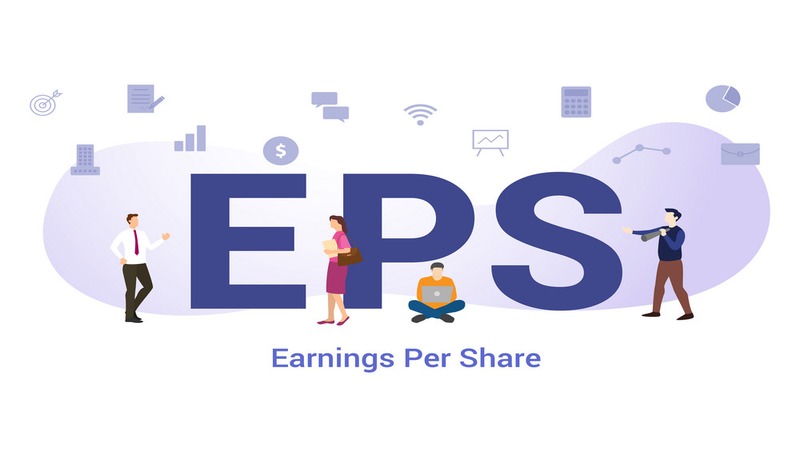1. What is EPS? Understanding Earnings Per Share in One Sentence
1.1 Basic Concept: How Is Company Profit Allocated?
EPS stands for Earnings Per Share, which refers to the portion of a company’s net income allocated to each outstanding share during a specific period.
Think of EPS as a cake: the company’s total earnings are the whole cake, and the number of shares you hold determines how many slices you get.
📌 EPS Calculation Formula:
EPS = Net Income After Tax ÷ Outstanding Common Shares
A higher EPS generally indicates stronger profitability. However, don’t assume that “high EPS = soaring stock price,” as the reality is more complex.

2. Types of EPS
2.1 Basic EPS vs. Diluted EPS: Which One Are You Looking At?
Investors often confuse EPS types, but the two most common are:
- Basic EPS
➤ Considers only the currently outstanding common shares.
➤ Applicable to companies without potential dilutive instruments such as convertible bonds or stock options. - Diluted EPS
➤ Includes potential securities that may convert into shares, such as employee stock options or convertible bonds.
➤ Provides a more realistic picture of the potential future earnings per share.
📌 Key Point: If a company reports a basic EPS of 3 but a diluted EPS of 2.4, it suggests potential share dilution in the future, which may reduce profitability per share. This warrants more careful analysis.
3. How to Interpret EPS: It’s Not Just About Higher Numbers
3.1 Does a High EPS Really Mean the Company Is Valuable?
EPS is an average measure of profitability and does not necessarily reflect total earnings. For example:
- Company A has an EPS of 5, but with only 10 million shares outstanding, its net income is 50 million.
- Result: Company B earns more overall, yet its EPS is lower. This shows that EPS does not account for total scale or share base.
Result: Company B earns more in total, but its EPS is lower. This shows that EPS does not account for overall scale or share base.
3.2 The Source of EPS Growth Matters
EPS growth can come from:
- Operational Growth: Driven by core business profits, more reliable.
- Non-recurring Gains: From asset sales or one-off income, not sustainable.
To avoid misleading signals, analyze the structure behind EPS: examine the source of net income, gross margin, and whether revenue is also increasing.
4. Does EPS Affect Stock Price? Yes, but It’s Not the Only Factor
4.1 The Interaction Between EPS and Stock Price
Under the efficient market hypothesis, stock prices reflect expected future earnings. EPS is one tool to measure this.
However, markets are driven by sentiment. Even strong EPS may not prevent stock declines if the economy slows, the industry weakens, or institutions sell off.
EPS impact on stock price can be categorized into three scenarios:
- EPS rises, stock price follows: Ideal scenario.
- EPS rises, stock price stagnates: Already priced in.
- EPS rises, stock price falls: Profit quality concerns or weak financial indicators.

5. How to check EPS? Fast and accurate methods
5.1 Three main channels for beginners:
- Public financial reports (company websites / stock exchanges / Market Observation Post System)
- Brokerage trading platforms (both Taiwan and US stock platforms provide this data)
- Financial news websites
It is recommended to prioritize official or transparent sources to avoid relying on incorrect figures.
5.2 EPS works better when combined with other indicators
Looking at EPS alone is one-sided. In practice, it is advised to combine it with:
- Price-to-Earnings Ratio (P/E) = Stock Price ÷ EPS
- PEG Ratio = P/E ÷ EPS Growth Rate
- Gross Margin / Operating Margin: To determine whether profits come from core operations
6. Can EPS be used for stock selection? Yes, but with steps
6.1 Practical application process for EPS
- Identify companies with stable EPS growth
➤ For example, firms whose EPS has risen steadily over the past five years. - Combine with industry cycles and trend evaluation
➤ Is EPS growth driven by structural change or one-time events? - Compare EPS with peers
➤ Check whether peer companies’ EPS lags or leads. - Set a target EPS and map it to a fair stock price
➤ Estimate a reasonable price range using EPS and P/E multiples.

7. How should beginners practice? Start with a demo, then move to trading!
7.1 If you want to apply EPS in real trading, do not skip these two steps:
- First open a demo account to practice analysis and order placement, observing how stock prices react to EPS announcements.
- Once you build confidence in your strategy, apply for a trading account to invest real funds and establish discipline.
Simulation → Backtesting → Strategy adjustment → Real trading is the essential path for every investor.
8. Conclusion: What is EPS? A shortcut to understanding a company’s fundamentals
EPS is a cornerstone of investment analysis, allowing you to quickly assess whether a company’s earning power is convincing. But it is not a cure-all. Relying on EPS alone without considering other indicators will make you a blind investor.
💡 Key tips:
- EPS should be analyzed as a trend, not a single data point.
- Combine EPS with gross margin, revenue, and capital structure for better insight.
- Use a demo account to practice before applying EPS in real trading, so you truly understand how to profit with it.

9. FAQ
Q1: Is a higher EPS always better?
A1: Not necessarily. A high EPS does mean the company earns more per share, but you must understand where the “high” comes from:
- Is it from core operations or from selling assets?
- Is it a long-term growth trend or just a one-time spike?
Only steadily rising EPS has real reference value. A sudden quarterly jump should raise caution about one-off gains or short-term maneuvers.
Q2: Does a negative EPS mean the company is uninvestable?
A2: Negative EPS means the company incurred a loss in that period and did not generate returns for shareholders—but it does not mean it has no investment value. Startups or biotech firms in the R&D phase often show losses, but once their products hit the market, revenue can surge.
The key is distinguishing between “structural losses” and “growing pains.” If it’s the former, long-term negative EPS requires great caution; if the latter, use other financial indicators to judge potential.
Q3: Where can I find EPS in financial reports?
A3: EPS is usually listed at the bottom of the consolidated income statement or clearly shown in the financial highlights section.
If you don’t want to read the full report, you can check the Market Observation Post System, broker platforms, or investment sites. But always verify the source and update date to avoid using outdated figures.
Q4: Can EPS be used to predict stock prices?
A4: Indirectly yes, but EPS alone is not enough. It is usually combined with “forecasted EPS” and the P/E ratio to estimate a fair price range:
Example:
If a company’s forecasted EPS for this year is 5, and the reasonable P/E range is 10–15, then the fair stock price should be between 50 and 75.
But remember: forecasts are uncertain, and market sentiment or macroeconomic changes can all impact stock prices. EPS is a reference point, not a guarantee of future performance.




